I have loved Washington D.C. ever since my first visit in the early 2000s. For travelers, the city offers that perfect blend of vibrancy, accessibility, culture, and history. Moreover, the distinct neighborhoods and friendly people remind me of San Francisco. Over the years, as work continued to bring me back to America’s capital, my love affair with D.C. continued. I even filed it in the back of my brain as a potential place to live. It should therefore come as no surprise that I was eager to share Washington D.C. with my kids. However, I wanted their visit to be both memorable and enriching. To me, that meant waiting until they were old enough to fully appreciate all that Washington D.C. has to offer.
I finally got the chance to take my kids to D.C. this spring. My eleven-year-old is a bit of a history buff, and my eighth grader is studying the American Revolution in school. It seemed like perfect timing. And it was. We walked our legs off, but it was easily one of the most enjoyable, educationally focused, trips that we’ve taken.
Here is our rundown of things you need to show your kids in Washington D.C.; listed in order of preference by my own children.
National Archives Museum
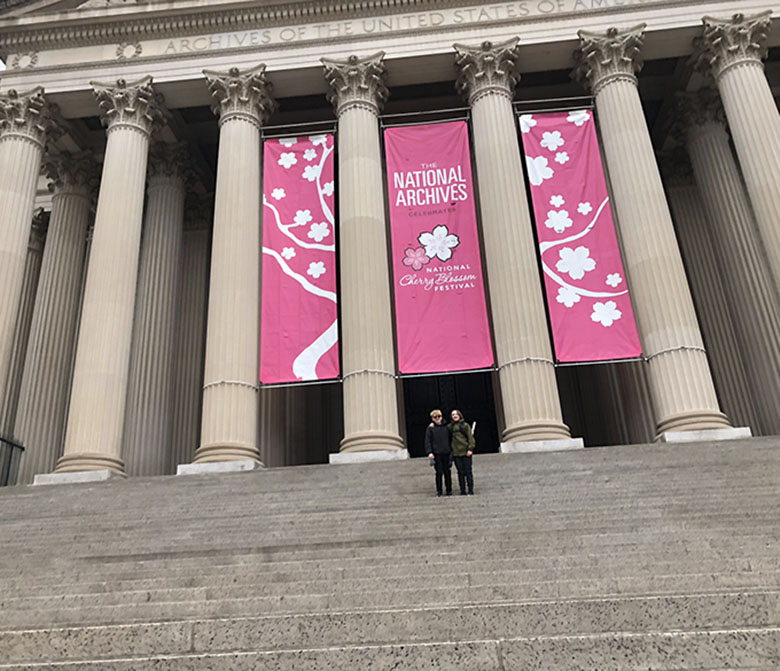
When people think of the National Archives Museum, they either think of the Declaration of Independence, the Nicolas Cage movie “National Treasure,” or both. Certainly, the Rotunda, where the Bill of Rights, Constitution, and Declaration of Independence are housed, is must-see. The room elicits the same kind of hushed awe as the Sistine Chapel in the Vatican Palace. And seeing these founding documents so perfectly preserved is an incredible experience. It certainly met every expectation for my kids, who had placed seeing the Declaration of Independence at the top of his Washington D.C. wish list.
However, for me, it was the Public Vaults that truly blew my mind. I’ve never seen such a diverse collection of historical documents in one place before. I could have spent hours in this one section of the museum alone. However, to give you a taste, here are a few of the things that we marveled at. The Emancipation Proclamation, the Tennessee ratification of the 19th amendment, the Belgian Treaty, the first moving images of Teddy Roosevelt, correspondence from George Washington, a census entry for Susan B. Anthony, a handwritten note from George Bush about the enormity of Reagan being shot, engineering plans for Alcatraz, and a WWI poster.
There is also another section of the National Archives Museum that you should see if you have the time. It is the Records of Rights exhibit. It not only has an original 1297 Magna Carter, but also provides a fascinating look at how rights have evolved over the years. Think slavery, women’s rights, and immigration. As an immigrant who has gone through naturalization myself, I was particularly fascinated by some of the records on display. For instance, I never knew Albert Einstein emigrated from Bermuda.
Pro Tip:
- Skip the line by reserving your ticket online in advance. And, if possible, secure the first timed entry of the day. Then, upon entry, immediately make your way to the Rotunda. This will give you unfettered access to the founding documents before the crowds ascend.
George Washington’s Mount Vernon
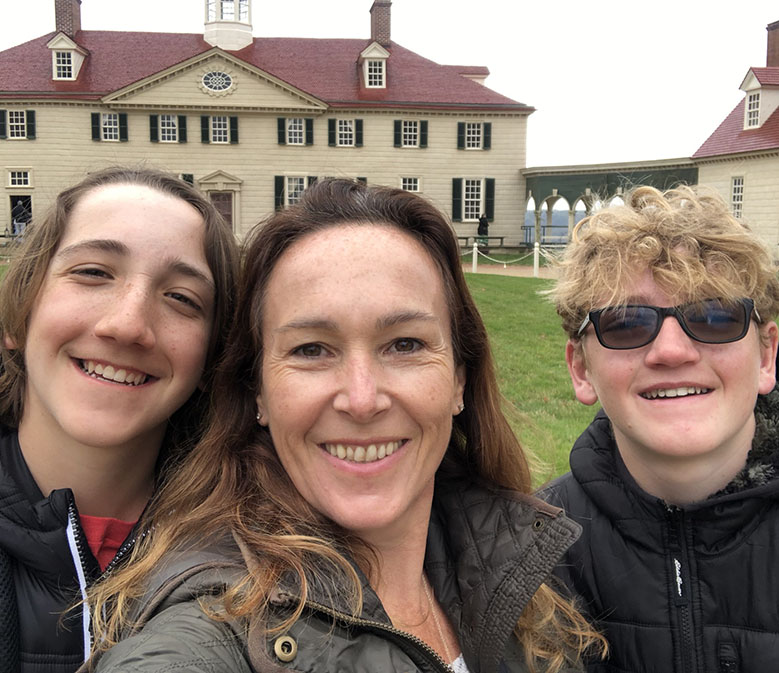
Even though it is in Virginia, Washington’s former home needs to be part of any kids trip to Washington D.C. Privately owned and operated (since 1858), it is a wonderful example of how historic residences can be preserved for future generations. While not as elaborate as the National Trust stately homes that I grew up with in England, the Mount Vernon Ladies’ Association has done a wonderful job furnishing the Mansion with original objects, period pieces, and reproductions. The result is a window into what 18th century life was like for George Washington, as well as those on his estate.
Because the property is huge, there is a lot to see and a lot to learn. A good place to start is the museum and education center. Here you will get an overview of Washington’s life. You will learn how he was uprooted by the death of his father. How he reinvented himself to rise above his limited means. How he became a leader, an entrepreneur, and America’s first president. This insight will provide extra context as you tour the grounds.
The estate has various outbuildings. The most impactful being the reconstructed slave quarters, where you will learn what life was like for the 317 slaves who labored on the property. Original buildings include the staff quarters, storage facilities, and things like the kitchen, smokehouse, washhouse, and spinning house. As you stroll, you will also get a feel for Washington’s enthusiasm for progressive farming techniques. For instance crop rotations, dung repositories, and “ha-ha walls”. And you will learn how Washington excelled entrepreneurially via his merchant mill, fisheries, and distillery.
However, the true highlight is the mansion itself. You can walk through the very same rooms that Washington cherished for almost 45 years. Just make sure you purchase a separate Mansion Tour ticket in advance. Day-of tickets sell out fast.
Pro Tip:
- The easiest way to get to Mount Vernon is via a leisurely boat ride on the Potomac River. A child ticket with City Experiences costs $49.95 and includes entrance to Mount Vernon as well as a Mansion Tour.
- When you arrive at Mount Vernon, pick up an “Adventure Map”. This map provides a little more excitement by asking a series of nine clues. Once your child has their answers, they can solve a word puzzle about George Washington. Prizes are available at one of the desks in the Education Center.
Ford Theatre
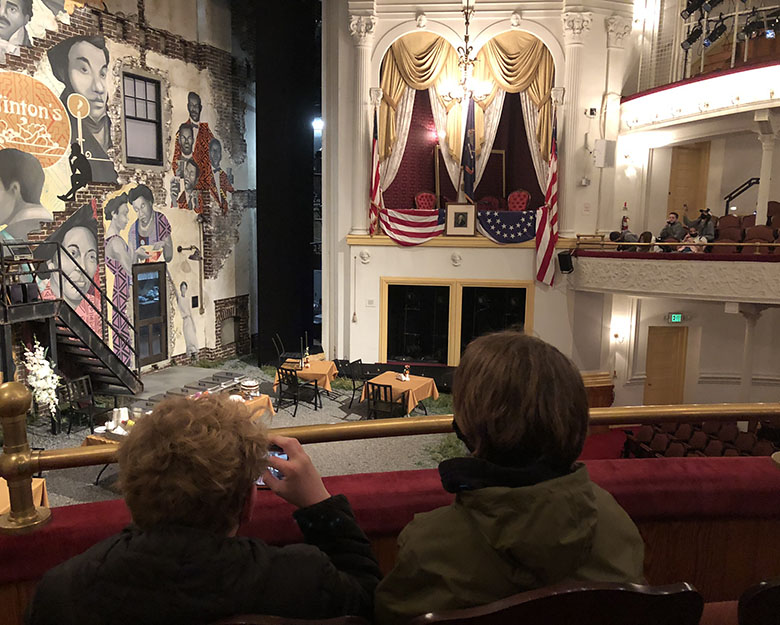
Visiting the site of a murder may seem a little gruesome for children. But some kids may want to see where Abraham Lincoln was assassinated in Washington D.C. Ford’s Theatre Museum intricately maps out the events leading up to and after the assassination. And, for the morbidly curious, you can see the actual gun that John Wilkes Booth used to assassinate Lincoln. Although the pillow with Lincoln’s blood on it is the thing that my youngest still talks about to this day.
After touring the museum, climb the stairs to the theatre itself. Here you will find the Presidential Box where the assassination took place. The box looks just like it did on that fateful night in 1865, thanks to careful restoration. While the public can’t go inside, you can get a good view of the box from the balcony opposite.
Tickets to Ford’s Theatre are only $3 per person. However, you should purchase them well in advance as they are extremely popular.
Pro Tip:
- Splurge on handheld audio guides for everyone in your party. The rental cost is $5, but it is well worth it. Just make sure to pay attention to the numbered exhibits in the museum. The audio tour does not start right next to the stairs where you enter.
- After visiting Ford’s Theatre, don’t forget to cross the road to the Peterson House. This is where Lincoln died from his gunshot wound. However, if you are short on time, you can skip the Aftermath Exhibits as most of this information is in the museum.
FUTURES
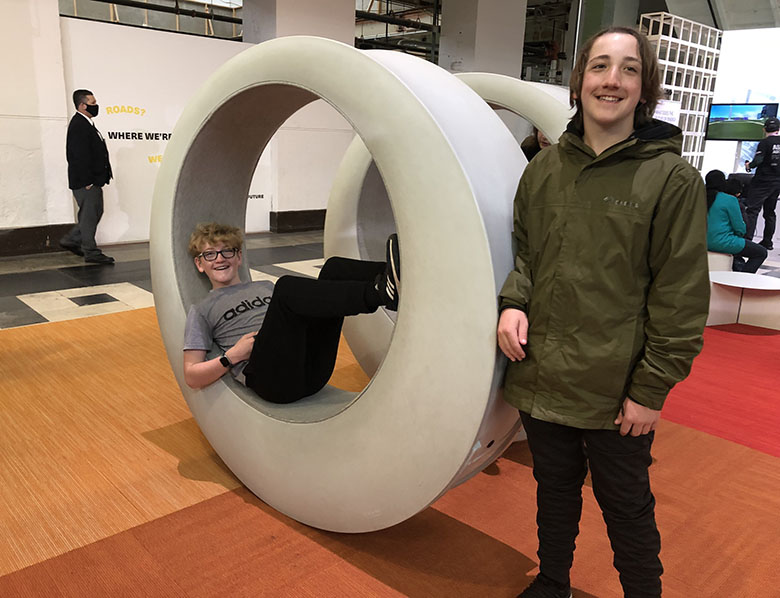
If you are thinking of visiting Washington D.C. with your kids before the end of summer 2022, FUTURES needs to be on your list. Presented by the Smithsonian, it is self-described as “part exhibition, part festival.” But I don’t think this does it justice. The museum incorporates art installations, interactives, experiments, inventions, speculative designs, and “artifacts of the future”. It also features historic objects and discoveries.
The cavernous venue is set up to convey a futuristic vibe. Even though the first exhibit that greets you is a celebration of the past. Here you will find memorabilia from various World Fairs, as well as artifacts like Alexander Bell’s Experimental Telephone (1876) and the first baby monitor (1937).
It’s not long before you see your first bit of new tech though. The “Doing Nothing with AI” is an amorphous robotic art installation. It fascinates kids with its ability to learn new choreography from each person it engages with. Then there is the Bell Nexus, a self-driving hybrid-electric air taxi. Not to mention Virgin’s Hyperloop, which is designed to transport passengers at record breaking speed. (For instance a trip from San Francisco to LA can happen in a mind-boggling 43 minutes). There is also a robot called Roomie that answers your questions. And a version of Minecraft, called EyeMine, that you play using only your eyes. Plenty of science is on display too. Particularly programs and initiatives that help create a future that is more responsible, sustainable, equitable, peaceful, and inclusive.
Essentially FUTURES is a museum where kids can imagine what the world can be. It presents possibilities and gets young minds thinking. What is better than that?
Pro Tip:
- The Arts + Industries Building, where FUTURES is located, is ideally situated within striking distance of several other museums. If you think your kids can handle back-to-back museums, consider parlaying a visit to FUTURES with a trip to another Smithsonian museum. For instance the National Air and Space Museum, the National Museum of Natural History, or the National Museum of American History.
International Spy Museum
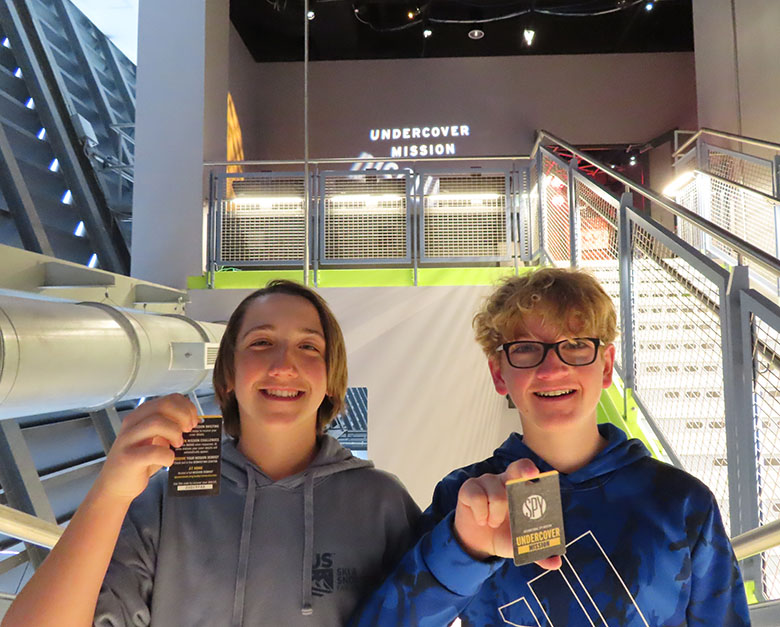
One of the best things about Washington D.C. is that most museums are free of charge for adults and kids alike. Unfortunately, this is not the case for the International Spy Museum. However, the $26.95 price tag for folks over the age of 13 is worth every penny. And you do not have to be a James Bond fan to appreciate the espionage artifacts either. Although the 007 Aston Martin in the lobby is a seriously nice touch!
Spread out over two floors, the museum does a great job showcasing the tools of the trade (past and present). It also shares real-life stories, and provides interactive exhibits. Along the way, you can test your undercover skills by participating in your own mission using a secret cover identity. Long story, short, it is easy to spend a few hours or more here and you walk away with a lot more covert knowledge than you came in. Did you know that dolphins can be trained to perform intelligence missions?
Pro Tip:
- I know gift shops are every parent’s nightmare when traveling with kids. But the Spy Museum Store is worth a quick visit. Aside from the usual fare of books, t-shirts, and tourist trinkets, they sell novelty spy items. Things like wallet lock pick kits, Cipher Wheels, Cryptex Combination Safes and safes that look like soda cans.
Inside the Washington Monument
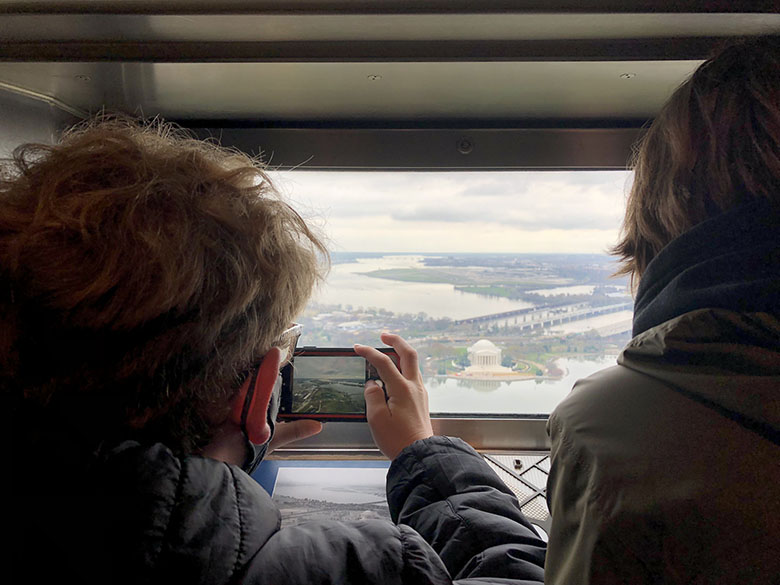
Call me crazy, but I think there is something truly special about going inside iconic vertical landmarks. Over the years I’ve enjoyed climbing the Eiffel Tower in Paris, the Tower Bridge in London, the dome of St Peter’s Basilica in Vatican City, and the Empire State Building in New York. The Washington Monument offered a similar thrill. Built to honor the Father of America, this 555-foot obelisk structure is every bit the marvel that the Washington National Monument Society intended.
Interestingly, if you look closely, you will see the monument has a two-tone appearance. This is due to an unforeseen two-decade delay in construction (due to funds drying up and the civil war). By the time construction was ready to resume, the original quarry was unable to provide additional marble. As a result, builders used new stone from a quarry in Massachusetts. However the color did not match. The remaining two-thirds of the structure therefore came from a third quarry.
Of course, none of this detracts from the engineering feat. As you go inside you get a feel for just how massive the 9-foot-deep blocks of stone are. And, as you take the small elevator 500 feet up to the observation deck, you cannot help but wonder how the builders were able to stack the stones as high as they did.
Once at the top, there are two windows on each side of the tower. These offer kids, and adults alike, unique views of Washington D.C. to the north, south, east, and west. For guidance, there are charts above each window that detail notable points of interest. As you make your way around the deck toward the return elevator, check out the displays. Then get ready to be vigilant as you travel back down. There will be a couple of brief stops to show some of the stone tributes in the old stairwell. These come from various states, cities, countries, and civic groups, and honor America’s first president.
Pro Tip:
- Like many attractions in Washington D.C., your kids can tour the Washington Monument for free. However, day-of tickets go fast. That is why it is worth paying the $1 fee to pre-purchase your tickets up to 30 days in advance.
Hirshhorn
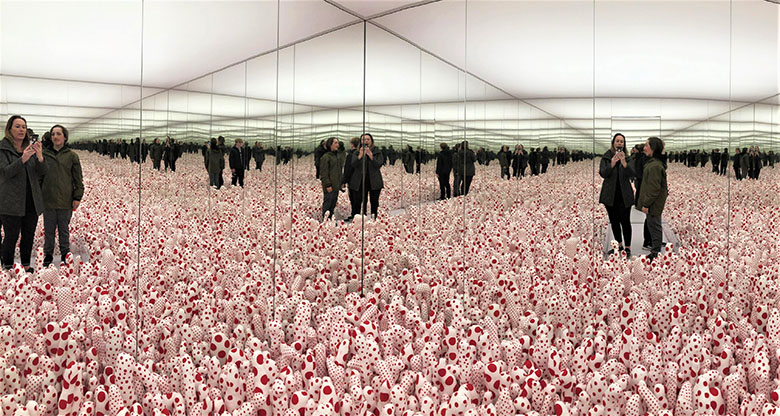
In recent years, I’ve been making a concerted effort to introduce my kids to art. We have visited places like Marfa, Texas (known for its minimalist art installations), various sculpture gardens across the country, as well as fabulously curated museums like the Palm Springs Art Museum. The Hirshhorn was therefore high on my D.C. places-to-visit list. Not just because it is a well-recognized national museum of modern and contemporary art, but because it offers the chance for my kids to physically experience art through the Yayoi Kusama “One With Eternity” exhibit.
Kusama’s immersive Mirror Rooms were an unquestionable hit with my kids. Of the two Infinity Mirror Rooms on display, the 2018 My Heart Is Dancing into the Universe was their favorite. They were left wanting more and were sad when their time was up.
However, the Hirshhorn has plenty of other exhibits and artwork to catch the interest of children. The Laurie Anderson “The Weather” exhibition, while conveying concepts a little deep for kids, was fantastic visually. Her work covers the gamut. She is a true multimedia genius, and this audiovisual exhibit offers the opportunity to see everything from poems and stories, immersive pieces, projection and video art, to large canvas pieces.
Then there is the educational resource area in The Barbara and Aaron Levine Collection exhibit. This is where visitors can do hands-on activities inspired by the artist Marcel Duchamp. My kids loved making self-silhouettes using the power of light and shadow. Nearby there is also the large-scale linear work of Mark Bradford to marvel at.
Pro Tip:
- If you want to see One With Eternity, you will need to get to the museum early to secure a same-day timed entry pass. These are handed out at 9:30 am and, on some days, the queues for tickets start before 9 am. Distribution is on a first-come, first-serve basis. The higher up in the queue you are, the more flexibility you have with choosing your timeslot. Otherwise, be prepared for an afternoon entry and think about visiting somewhere else nearby that morning. (Note there is a great café called the Pavilion, in the nearby National Gallery of Art Sculpture Garden, that is perfect for lunch if you need to kill time).
National Mall and Monuments
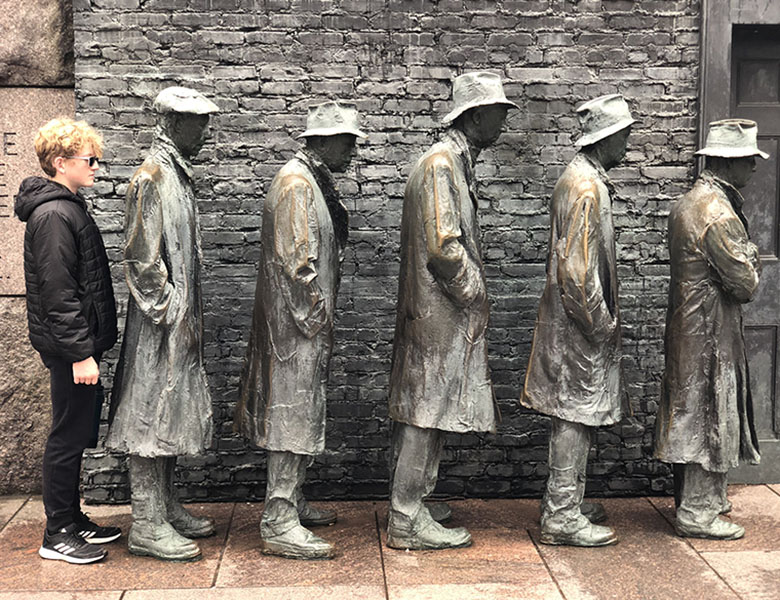
It is hard to think of Washington D.C. and not picture the various memorial parks in the National Mall. All are worth a visit and can easily be navigated on foot over the course of a couple of hours. However, the big ones include the Washington Monument (already discussed), the Thomas Jefferson Memorial, the Franklin D. Roosevelt Memorial, the Martin Luther King Jr. Memorial, and the Lincoln Memorial. The easiest place to start is the Thomas Jefferson Memorial, which is at the southernmost point. You can then parallel the Potomac River as you make your way north to the Lincoln Memorial.
The Thomas Jefferson Memorial is a huge circular colonnaded structure with a bronze statue of Jefferson in the middle. It sits at the bottom of the Tidal Basin and is directly south of the White House. While there is not a lot to see in the memorial, it does offer another vantage of the Washington Monument. It can also be quite beautiful in the spring. This is thanks to the Japanese cherry trees that were gifted by Tokyo in 1912.
The next stop is the Franklin D. Roosevelt Memorial. Unlike some of the earlier presidential memorials, this park is more free-flowing and does not feature a large marble structure. Instead, the memorial uses walls, water features, quotes, and sculptures to depict a timeline of Roosevelt’s presidency. It also conveys some of the challenges that the American people faced at this time. For instance the Great Depression and World War II. The Breadline sculpture (pictured above) is particularly powerful.
The Martin Luther King Jr. Memorial is only a short distance from the Roosevelt Memorial. It oozes symbolism, starting with its location at 1964 Independence Avenue which references the year of the Civil Rights Act. However, it is the “Stone of Hope” where Dr. King’s image emerges that really wows. Reminiscent of Mount Rushmore, it is a nod to a line from King’s 1963 “I Have a Dream” speech. Indeed, the sculpture creates a feeling of optimism. As do the quotes, and the band of light that runs the entire length of the memorial’s concave wall.
Last, but not least, is the Lincoln Memorial. Immortalized by a 19-foot marble statue at the center of the structure, the tribute to Lincoln is nothing short of impressive. From the memorial’s sheer size, to its Grecian temple design which includes 58 steps and 36 columns. It is also perfectly positioned to elicit a mirror image in the Reflecting Pool. If the memorial is not too crowded, take a look at the wall on the left. It has every word of Lincoln’s famous Gettysburg Address etched into its stone.
Pro Tip:
- The Lincoln Memorial is extremely popular and can get very crowded, particularly during tourist season. You will therefore want to plan your visit for either early in the morning or late afternoon/early evening.
- If you have the time, make a day of the memorial parks. Pack a lunch and take a leisurely stroll. You can also build in some fun on the water by pre-booking a pedal boat.
The White House
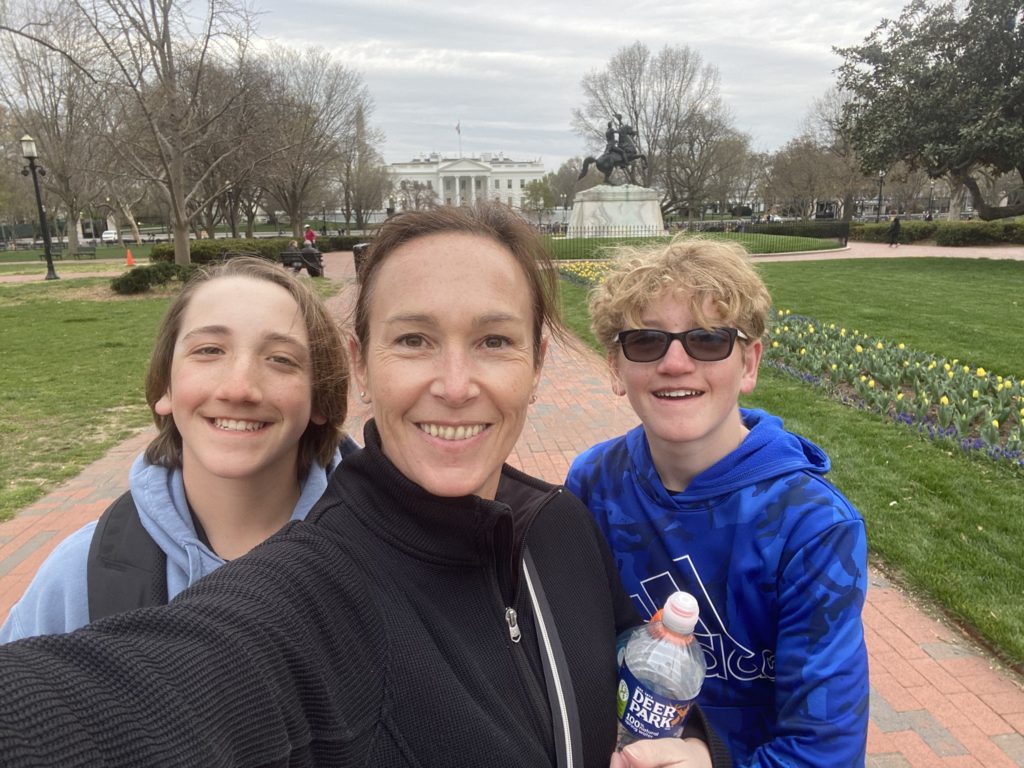
What child does not want to see where the President lives? If you plan ahead, you can secure a free tour of the White House through your local member of congress. Once you are less than 90 days out from your trip, simply place a request with your representative. However, if the White House isn’t available for a tour during your trip, make your way to Lafayette Square. You can get a great view of the presidential mansion at the bottom.
Pro Tip:
- Keep your eye out for any motorcades in the vicinity. And, if you see Pennsylvania Avenue NW barricaded, ask one of the policemen how long it will be in place. They could be preparing for a special arrival or departure. This means you may get lucky and have the chance to wave to the President as we did!
National Museum of Natural History
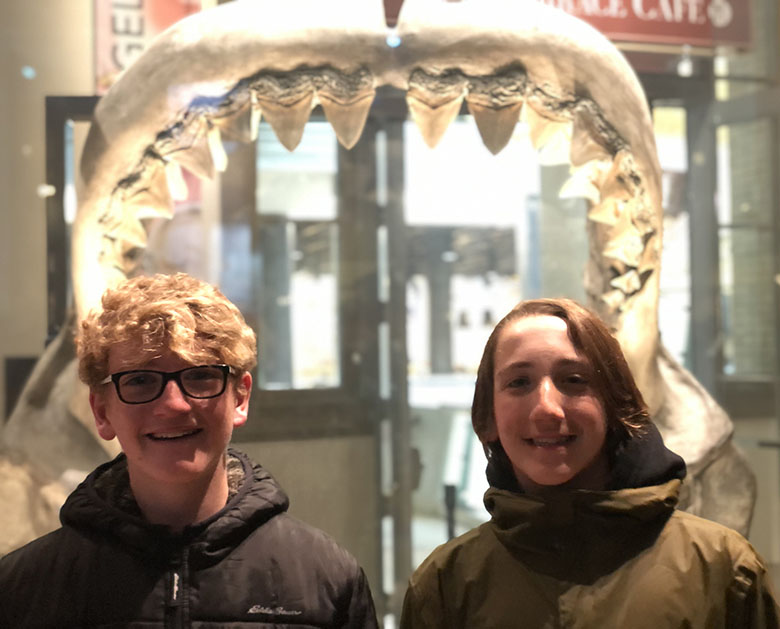
I am a big fan of natural history museums. I have been ever since my first visit to the Natural History Museum in London when I was a child. That is why I’ve made a point of taking my kids to various natural history museums here in the U.S.
The National Museum of Natural History in Washington D.C. is one of the best. Conveniently located on the National Mall, the museum is nothing short of huge. But it needs to be – there are more than 146 million objects and specimens on display. These items include everything you would expect from a world-class natural history museum. From dinosaur fossils to Egyptian mummies, taxidermy of exotic African mammals, to bone reconstructions of early man. Along the way, the museum intersperses interactive stations to help the experience come alive. Speaking of alive, the museum also has a butterfly pavilion where you can walk among butterflies, as well as an insect zoo.
Pro Tip:
- The museum can get busy. But that is to be expected from the most visited natural history museum in the world. If you can, travel light so you can move quickly through security. Also come with a full stomach as the lines to the Atrium Café can get long. Additionally, you may want to split your visit in two, to give yourself enough time to see everything you want. As with other Smithsonian museums in Washington D.C., entrance for you and your kids is free.
National Gallery of Art
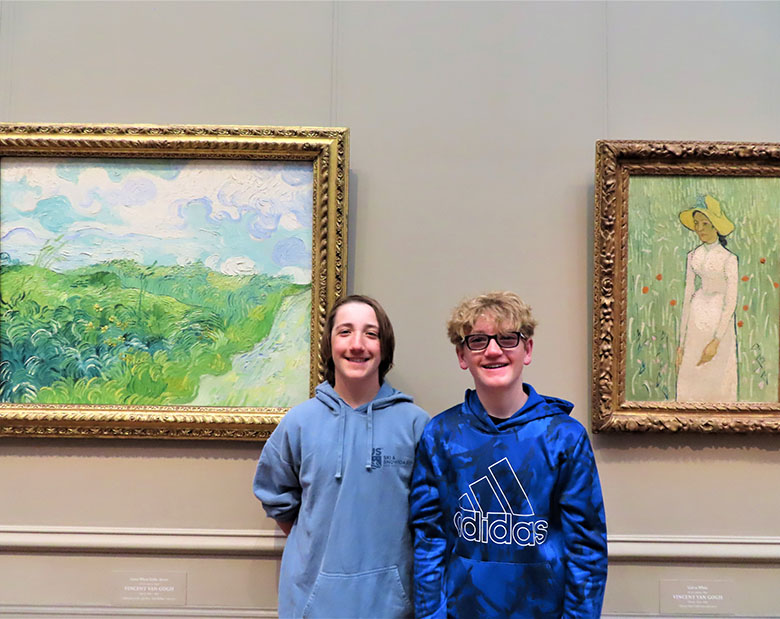
If you plan to take your kids to the Hirshhorn in Washington D.C., you should also consider a trip to the National Gallery of Art. The art displayed on the main floor and ground floor offer a stark contrast to the modern and contemporary art at the Hirshhorn. From 13th century sculptures, and Renaissance portraits, to paintings created by Rembrandt, there is a lot to see. Plus the museum has work from impressionist masters like Monet, Renoir, and Van Gogh. The result is an art museum that provides a tour back through time. Kids not only get to see a prolific collection of art up close but, through landscapes and genre art, they get an artist’s interpretation of what life was like two, three, four, five, and six hundred years ago.
Pro Tip:
- Kids can have a short attention span. At least, I’ve found that to be the case with my own children. I, therefore, suggest entering the museum with a game plan of what you want to see. If your child studies art and already knows certain styles, focus on exhibits that complement this knowledge. If your child is interested in history, show them portraits of Napoleon and George Washington, as well as pictorial representations of scenes and events from everyday life.
Happy Travels!
Author’s Note:
The secret to any successful trip is to plan ahead. Know what is available, what is open, and what needs to be pre-purchased. Unfortunately, at the time of our visit, the Smithsonian National Air and Space Museum, and tours of the Capital and FBI building were not available due to renovation and COVID restrictions. We also wanted to see the National Museum of American History. However, its opening hours did not align with our schedule.
